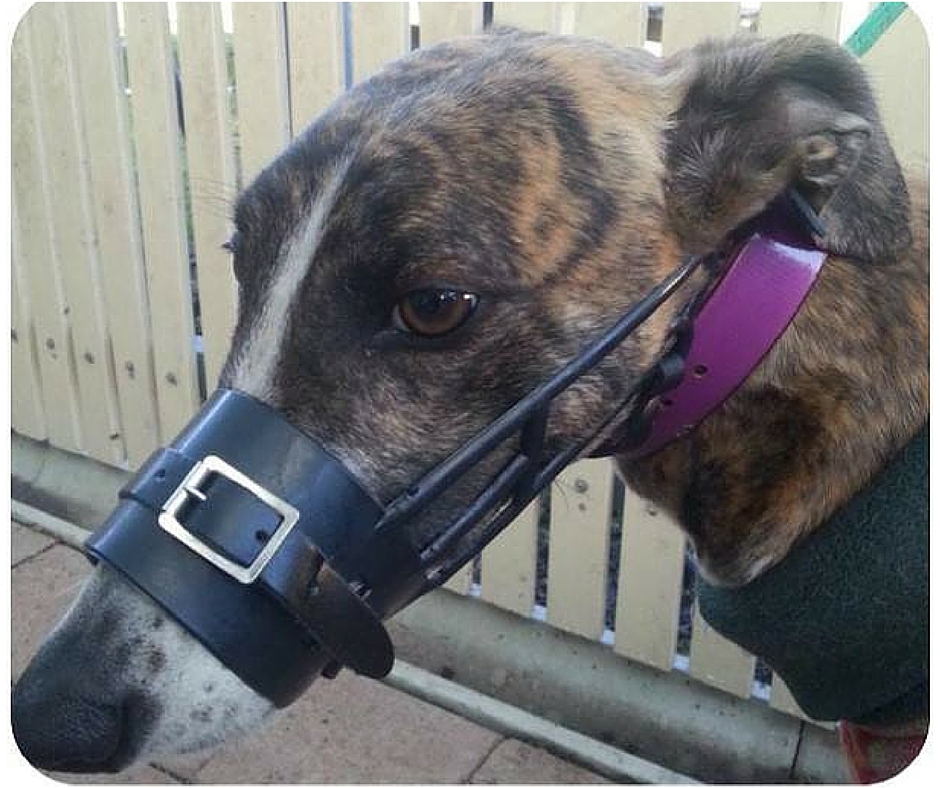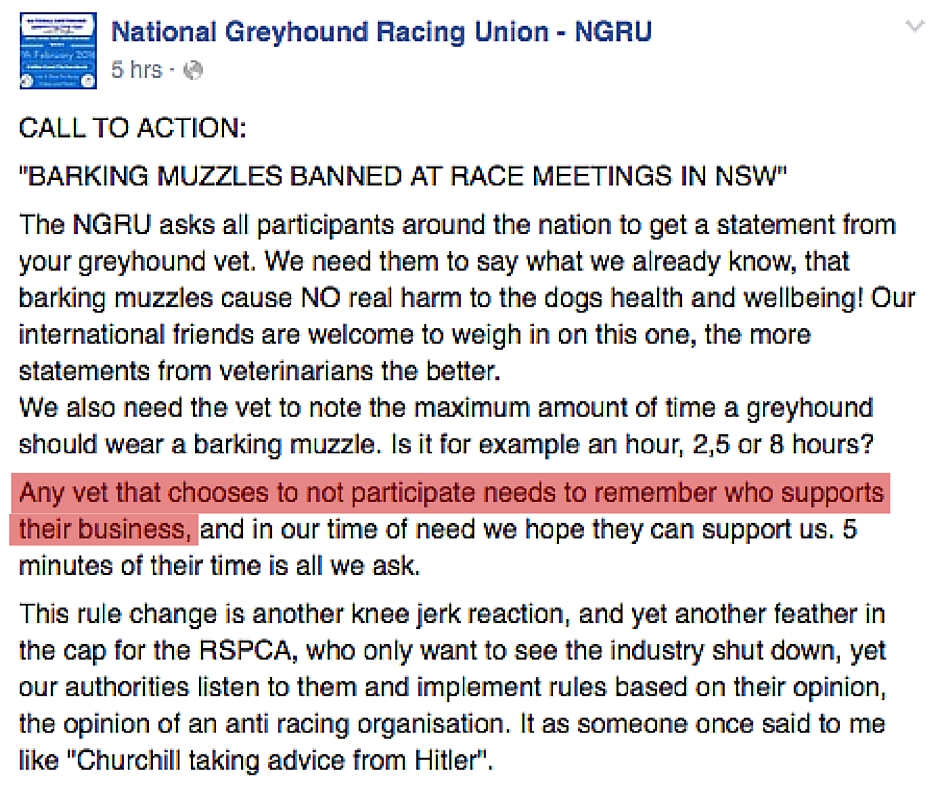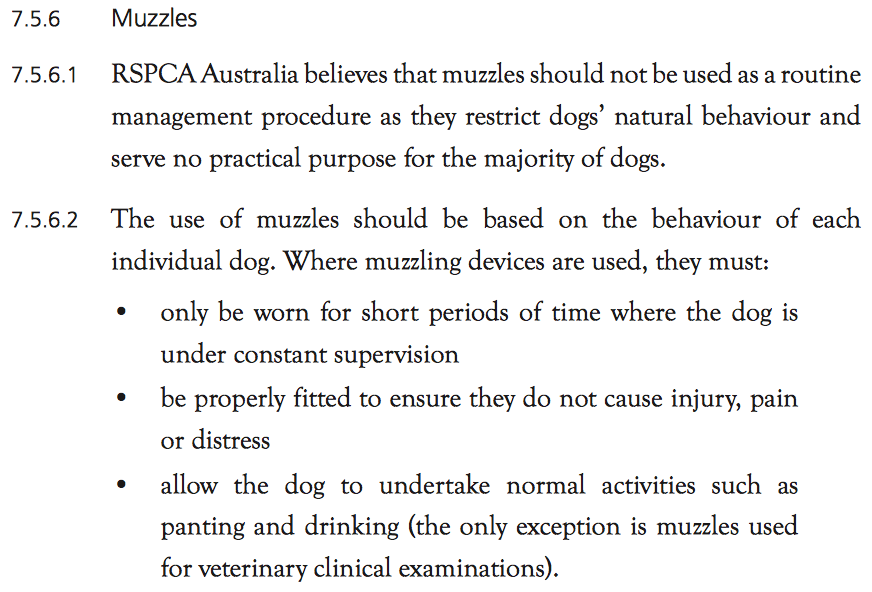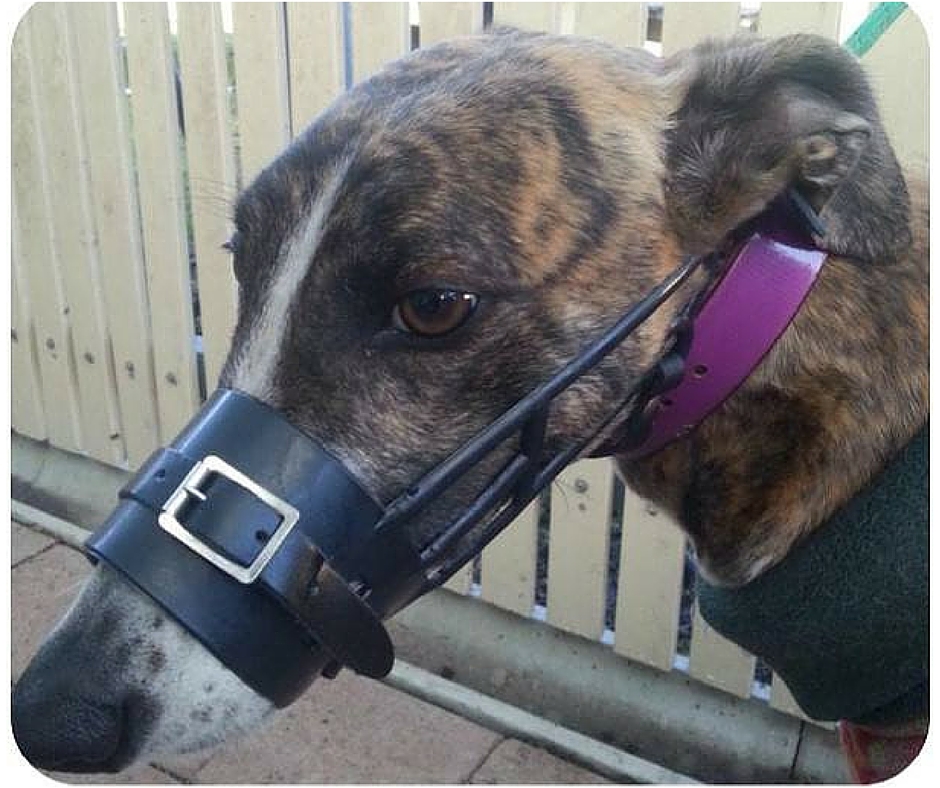A couple of weeks ago, the tragic death of a greyhound due to barking muzzle usage came to light. She and her 14 kennelmates had been muzzled with these archaic devices and left to fend for themselves, unable to open their mouths, on a Rockhampton property. The temperatures rose to 35 degrees while their trainer was out. It is a miracle only one of them died.
Barking Muzzles: What’s the Problem?
For those of you who have not seen a barking muzzle before, here’s what one looks like:

While muzzles have been used in the past to prevent barking, the common consensus in this day and age is that muzzling a dog for extended periods of time is cruel, dangerous and completely ineffective because it does not address the underlying cause of the barking. A quick Google search will show you multiple webpages on dog training and dog behaviour: none of them recommend the use of muzzles to stop chronic barking and most highlight the potential dangers of unsupervised muzzle usage, such as overheating or injury. Here is the Working Dog Alliance‘s take on muzzle usage in the greyhound racing industry:
The practice of muzzling greyhounds for extended periods, either to reduce barking or eliminate biting/chewing is noted. Muzzling does not address the reason for the underlying behaviour in any way, and may act as a stressor to the dog. The use of muzzles can also inhibit the dogs’ natural cooling mechanisms – in hot weather or immediately after racing, this represents a serious welfare concern. Long term use, unsupervised use, selection of an inappropriate muzzle type and/or extended periods of muzzling can lead to compromised welfare and physical injuries.
In November 2015, several veterinarians testified at the Special Commission of Inquiry Into the Greyhound Racing Industry in New South Wales. Their testimonies rocked the industry and the media: a former track vet testified that GRNSW stewards were under-reporting racing deaths and injuries to avoid stirring up the greenies; another vet described trainers’ shocking DIY animal care practices and explained how the repetitive strain of racing inevitably causes career- or life-ending injuries.
Barking muzzles also came into the spotlight as a result of the Inquiry. The habitual long-term usage of barking muzzles as a ‘behaviour management’ device to prevent kennelled greyhounds from barking was revealed, along with its dire effects on the dog’s physical and mental health:
“…barking muzzles will stop the dogs from being able to pant effectively.
“Dogs also pant because they’re stressed and if they can’t do that that’s going to make them very stressed.
“…a lot of the kennels that I visited, they have a lot of these hanging up outside the kennels and even on dogs at the time.
“We often see dogs coming in for adoption with a lot of the enamel behind their canines being eroded from chewing on wire. Inter-dog aggression for greyhounds within kennels, barking within kennels, and chewing up their beds, and what concerns me is how widespread the use of muzzles are to control those vices, so either barking muzzles or basket muzzles to physically stop them from engaging in those activities that are actually designed to reduce the dog’s stress, which causes more stress, and stress obviously compromises welfare and contributes to wastage again.
“it is a real concern that they’re used as a first rather than a last resort, and the dogs being unable to pant. There was an unfortunate, in fact, I think there had been two incidents, where dogs actually vomited in the racing kennels at the track. They obviously can’t do anything about it, so those dogs died, and it can be extreme, and they are used with approval.”
After this testimony was heard, GRNSW hastened to play welfare catch-up and banned the use of barking muzzles at all NSW race tracks citing health and welfare reasons. While late is better than never, the question has to be asked: why have they tolerated the use of this device for so long? The Greens’ John Kaye brought barking muzzles up as long ago as September 2014, but GRNSW was happy to ignore the facts back then. Are they just pretending to care now because greyhound racing is an inch from losing its social licence?
GRNSW Banned Barking Muzzles – So Everything is Fine Now, Right?
It should be pretty obvious by now to anyone who’s reading this that barking muzzles are disgusting and the ongoing use of them on a long-term basis is animal abuse, plain and simple. So yes, GRNSW banning barking muzzles at race tracks is a step in the right direction, but it does not go far enough.
The real problem lies with the regular use of these muzzles when the dogs are away from the track; when they are bored, anxious or stressed and would normally pant, bark, chew or lick to soothe themselves, but can’t because a medieval torture device is clamping their mouth shut.

It is a legitimate concern that barking muzzles are used indiscriminately on an ongoing basis by industry participants as an ‘easy fix’ for dogs with underlying behavioural problems. In February 2016, Greyhound Racing Victoria (GRV) helped a trainer fill out an application for a breeding and training facility in Eden Park. This application stated that barking muzzles would be used to “minimise noise” from barking greyhounds. A similar statement is made in a Campaspe application for a 40-greyhound training facility (p.20), a Shire of Moyne application for a 45-greyhound facility (p.51), an Ararat Rural City application (p.102), a City of Greater Bendigo application (p.60), an East Gippsland Shire Council application (p.542) and a Langwarrin application for a greyhound-keeping and breeding facility (p.8 of the Planning Submission). It would seem that these greyhound trainers do not have the time or inclination to tackle the cause of their dogs’ barking with training or enrichment; instead, they have chosen to just go straight to the muzzle.
As for Gold Plated herself, the conduct of her trainer on the last day of her life indicates that the unsupervised usage of barking muzzles over extended periods of time is probably habitual behaviour for him:
On 1 March 2016 I.R.U. Officers attended Mr Johnson’s property after information was received that GOLD PLATED had died on Friday afternoon, 26 February 2016 after having a barking muzzle applied by Mr Johnson before he departed that morning.
Mr Johnson advised that he applied barking muzzles to the fifteen (15) greyhounds on his property prior to departing at 7:30 a.m. on 26 February 2016 before returning late that afternoon. Weather Bureau records show that the temperature in Rockhampton on this day rose to 35 degrees Celsius.
It is worth noting that Racing Queensland has sentenced Gold Plated’s trainer to a mere two-year disqualification. Doesn’t seem like much of a price to pay considering what he did, does it?
Greyhound Racing’s Participants ARE the Problem
Gold Plated’s demise highlights a culture of wilful ignorance and arrogant complacency within the greyhound racing industry. While her death should be a wake-up call for the regulators to ban barking muzzles entirely, whether they will be able to implement and enforce a ban is questionable because participants do not believe that these devices are detrimental to the greyhounds’ welfare. Their grounds for thinking so are dubious, as no scientific evidence sanctioning prolonged usage of these muzzles is cited; most participants simply appear to be convinced that they know more about animal care than qualified vets and dog behaviour experts.
Below are real responses from industry participants to GRNSW’s ban of barking muzzles at all NSW tracks; you’ll notice most of them seem more concerned about their dogs’ ability to perform on the track than about their health and well-being.

Some industry participants attempted to take this even further by calling on their fellow greyhound racers to blackmail their vets into signing statements that barking muzzles cause no harm to the greyhounds (see below). Given that the barking muzzle ban is still in place, it would seem that their only success is proving the lengths that they would go to in order to fight the racing regulators’ changes to improve animal welfare. Just another example of industry participants rejecting changes for greyhound welfare.

Time to Shut Greyhound Racing Down
After the live baiting scandal in February 2015, the message to the greyhound racing industry was clear: change or die. Based off the intensely negative reaction to GRNSW’s barking muzzle ban, it would seem that not many greyhound racing participants are happy to change. Racing regulators may be able to take a heavy-handed approach to misdemeanours at their race tracks, but who will monitor what goes on in every participant’s backyard? Last year’s MacSporran inquiry found that only 31 kennel inspections were undertaken the year before; that’s a mere 4.4% of all Queensland kennels. The reason cited for this was a lack of resources.
It is heartbreaking to realise that there could be more greyhounds like Gold Plated who died an agonising, slow death due to a barking muzzle. Her trainer initially tried to pass off her death as caused by a twisted bowel and quickly buried her; it is pure luck that the truth came out and her body was exhumed for examination by the RSPCA and IRU officers. There could be many other silent victims who were never reported, quietly buried somewhere by their killers and forgotten.
Please ask Racing Queensland what they plan to do to prevent more deaths like Gold Plated. At the time of publication, barking muzzle use in Queensland is discretionary – in other words, trainers can use them as much as they want, whenever they want. Please also share this blog far and wide so that people realise that greyhound racing cruelty doesn’t just happen on the track – it happens in every aspect of the dogs’ lives.
*NB: It should be noted that contrary to some industry participants’ beliefs, the RSPCA does not approve of the continued, long-term use of barking muzzles at home. In fact, based off their requirement that any muzzle used “allow the dog to undertake normal activities such as panting and drinking”, it would seem that barking muzzles are not condoned by the RSPCA at all. This statement is taken from the RSPCA Australia’s policies:

